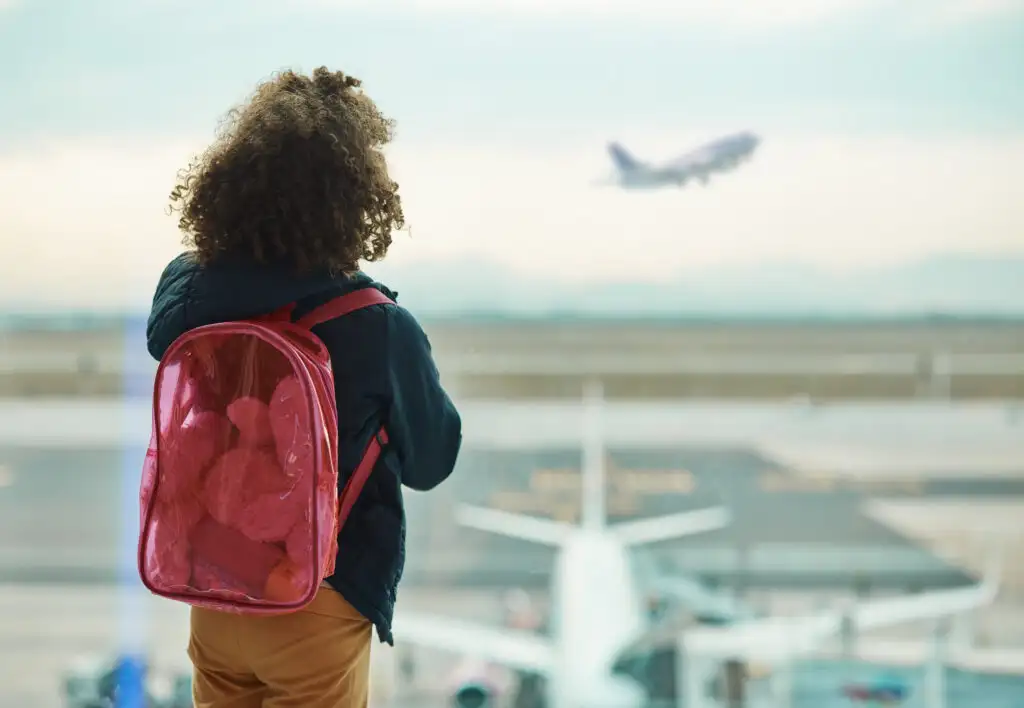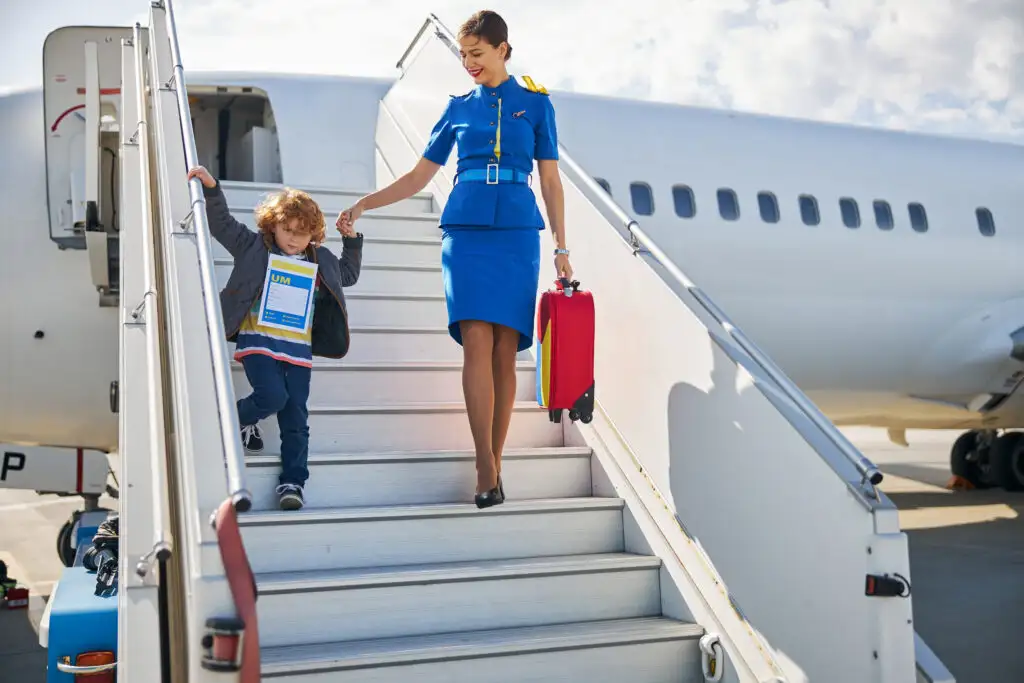If you are allowing your child to fly alone as an unaccompanied minor, be sure to take every necessary precaution to ensure his or her safety. Millions of children fly alone each year, the majority without incident. But there are occasional horror stories, like the time JetBlue mixed up two little boys and sent them to the wrong airports. That’s why it’s vital that both you and your child are fully prepared for the trip. Read on for important family travel tips on children flying alone.
How Old Do Kids Have to Be to Fly Alone?

Airlines generally consider children between the ages of 5 and 14 who travel without a parent or guardian to be “unaccompanied minors.” For kids between 15 and 17, unaccompanied minor service is typically optional.
Many airlines will not allow children 7 and under to make connections at all, but in the event a minor is old enough to change planes, they will be assisted by airline personnel. Some airlines—Southwest, for example—will not allow any minor (5 – 11) to change planes. JetBlue and Spirit will not allow any children under 15 to make a connection. Southwest and Spirit do not allow unaccompanied minors on international flights, while most other airlines do. Unaccompanied minors are often prohibited from taking codeshare flights.
If you intend to send an unaccompanied minor by plane, you will be required to fill out a form detailing the child’s name, age, and other relevant information. Upon arrival, your child will be escorted from the aircraft by an airline representative and released to the responsible adult named by you prior to departure.
General Age Guidelines for Unaccompanied Minors
Airline rules vary, but here’s a good idea of what to expect. Note that the ages listed below reflect your child’s age on the date of travel, not at the time of booking.
Children ages 1 – 4 may fly only when accompanied by an adult. A child must be at least 5 to fly solo.
Kids ages 5 – 7 can take a direct flight to a single destination but not connecting flights.
Those 8 and up may change aircraft on some airlines, and will typically be escorted by airline personnel to their connecting flight.
Anyone under the age of 17 who is flying alone on an international flight may be required to produce a signed letter of consent from a parent or responsible adult.
As these guidelines vary slightly by airline, be sure to contact your carrier for specific information.
Unaccompanied Minor Fees
Airlines charge anywhere from $35 to $150 each way for an unaccompanied minor fee. The exact amount will depend on the airline, the age of the child, and whether the flight involves connections. Some airlines charge a fee per child, while other carriers will allow multiple children to travel together under a single fee.
Below are the fees charged each way for unaccompanied minor service on some of the major U.S. airlines.
- Alaska: $50 per child for nonstop flights; $75 per child for connecting flights
- American: $150 (covers siblings, if applicable)
- Delta: $150 for up to four children
- Hawaiian: $35 per segment per child within the state of Hawaii; $100 per segment per child between Hawaii and another North American city
- JetBlue: $150 per child
- Southwest: $50 per child
- Spirit: $150 per child
- United: $150 for up to two children; $300 for three or four children; $450 for five or six children
Other Considerations for Minors Flying Alone
Some airlines do not allow unaccompanied minors to fly on the last connecting flight of the day, or on so-called “red-eye” flights between 9:00 p.m. and 5:00 a.m. Be sure to read each airline’s policies carefully before booking.
After filling out some paperwork and paying the appropriate fees at check-in, one parent or guardian will receive a special pass that will allow him or her to get through the security checkpoint. The parent or guardian must accompany the child to the gate and wait there until the plane takes off.
Important Tips for Children Flying Alone

Never wait until you have reached the airport to inform the airline that you have a minor traveling unaccompanied. Always provide this information to customer service over the phone, and have them inform you of all your options, fees, and so forth.
Try to purchase your child a nonstop ticket to minimize the chance of travel snafus, even if he or she is old enough to make connections. If a change of planes is necessary, aim to use a small, less intimidating airport for the transfer. That said, some airlines restrict which connecting cities are permitted for children flying alone.
Make sure your child carries plenty of emergency information. For example, leave instructions on how to handle flight delays or cancellations, including emergency contacts and a means to pay for necessities, such as overnight accommodation. Your child should also carry identification, such as a copy of his or her birth certificate.
Familiarize your child with his or her itinerary and make sure all travel documents are kept in a safe place—especially if they’ll be needed for a return flight.
Try to book a morning flight. If it is delayed or canceled, you have the rest of the day to make alternate plans.
Small children may have trouble with checked baggage. If possible, stick with a single carry-on bag and a personal item. If not, take a careful look at your child’s checked bag stubs to be sure that the luggage claim ticket and luggage tag match your child’s final destination.
Get to the airport earlier than usual to ease check-in and get children accustomed to their surroundings. If possible, show them where help desks are located and teach them to recognize uniformed employees.
Make sure your child has a photo of the person meeting him or her, as well as that person’s full name, address, and phone number. You will need to provide contact information to the airline as well. The adult meeting your child at the destination airport should carry photo identification.
Pack some snacks for your child such as chips, sandwiches, trail mix, or other finger foods like grapes or berries. You may also want to purchase juice or water for your child after you pass through the security checkpoint.
Be sure your child has plenty of things to keep him or her entertained in flight, such as a tablet stocked with games or a few favorite books.
Give your child a little cash to cover incidental expenses in the event of an emergency.
Just because a 5-year-old is permitted to fly solo, that doesn’t mean that your 5-year-old will be able to handle flying alone, especially if your child hasn’t flown before. Parents should use common sense and make a decision based on their own child’s level of maturity.
Airline Policies for Unaccompanied Minors
Click on the link below to find your airline’s policy on children flying alone.
Editor’s note: This story was originally published in 2017. It has been updated to reflect the most current information.
You Might Also Like:
• The 7 Most Controversial Travel Opinions• Travel Size First-Aid Kit: What to Pack & Downloadable Checklist
• The Ultimate New Hampshire Summer Weekend Guide
• How Early Should I Get to the Airport?
• The Best Over-the-Counter Sleeping Pills for Long-Haul Flights
We hand-pick everything we recommend and select items through testing and reviews. Some products are sent to us free of charge with no incentive to offer a favorable review. We offer our unbiased opinions and do not accept compensation to review products. All items are in stock and prices are accurate at the time of publication. If you buy something through our links, we may earn a commission.
Related
Top Fares From
Today's Top Travel Deals
Brought to you by ShermansTravel
France: 8-Night Paris, Avignon & Nice...
Infinity Worldwide Vacations
 vacation
$2880+
vacation
$2880+
Poconos: 3 Nts in Garden of...
ResortsAndLodges.com
 hotel
$305+
hotel
$305+
7-Nt Canada & New England Cruise,...
Princess Cruises
 cruise
$839+
cruise
$839+




